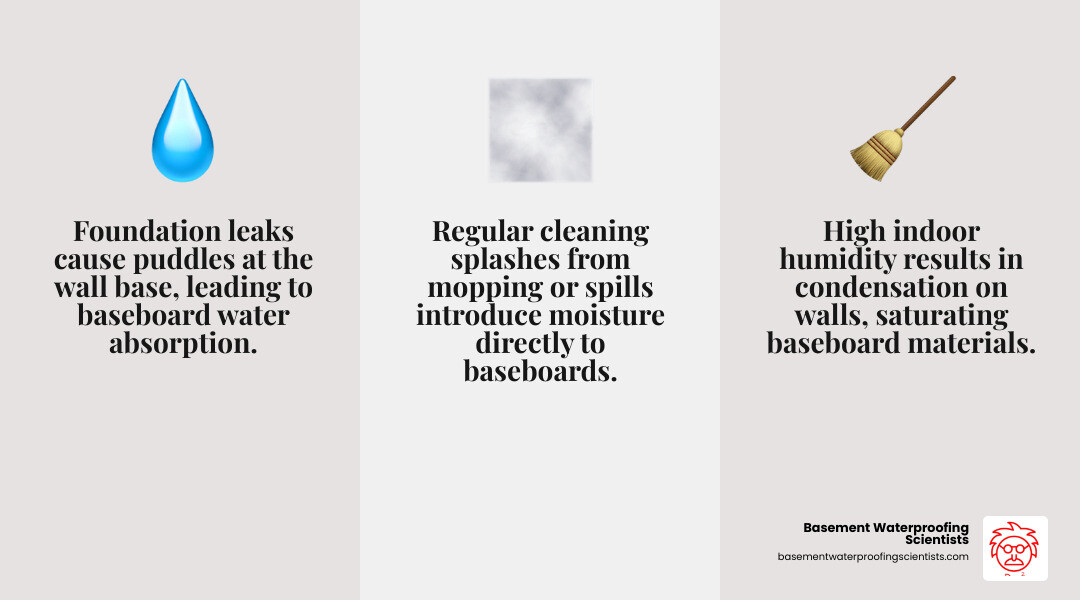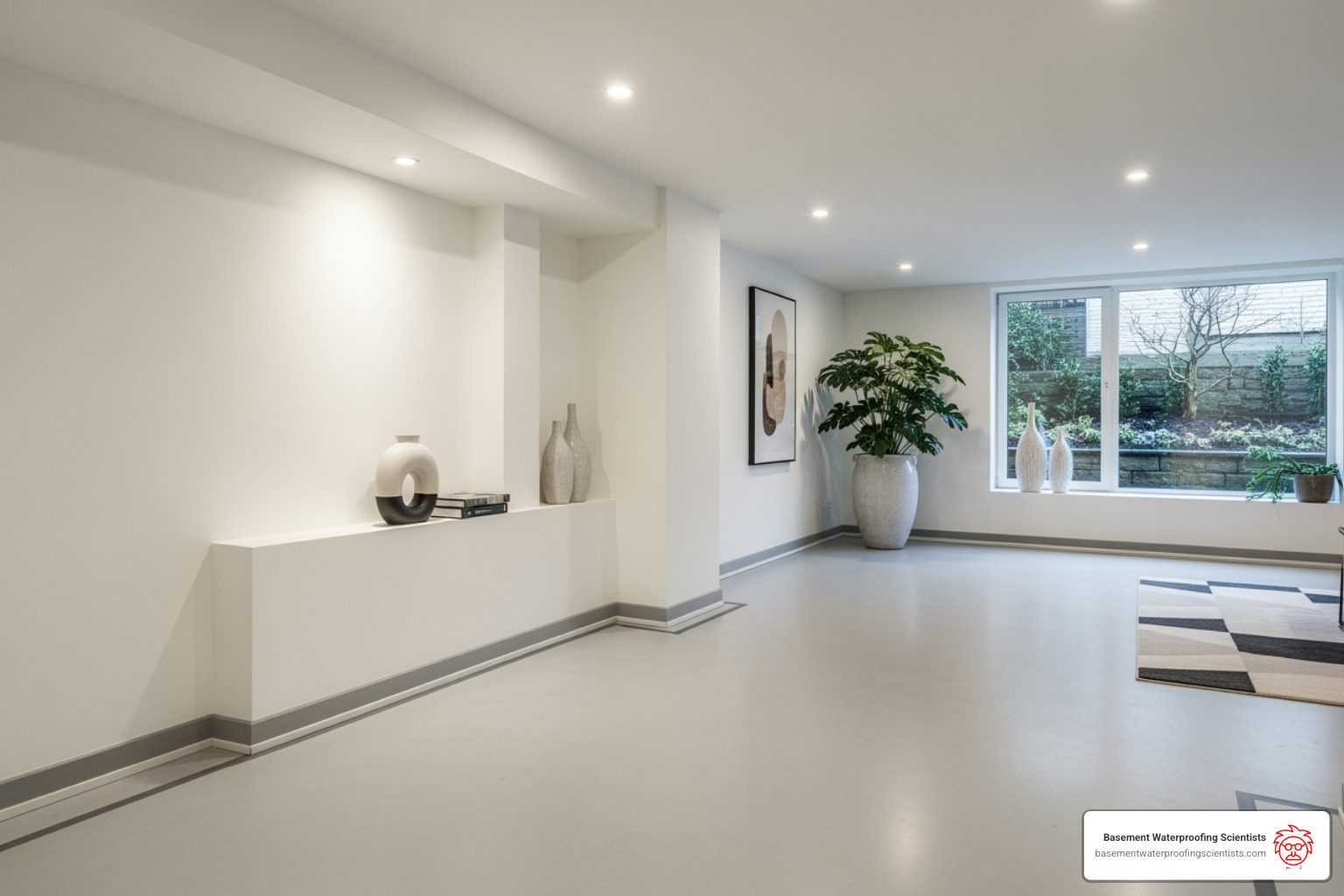Why Waterproof Baseboards Are Essential for Your Home
A waterproof baseboard is a moisture-resistant trim piece that protects the bottom of your walls from water damage, mold, and rot. While often seen as a decorative afterthought, its functional role is critical, especially in vulnerable areas of your home. Here’s what you need to know:
Key Materials:
- PVC/Vinyl – Cost-effective and flexible
- Polyurethane – 100% waterproof with wood-like appearance
- Rubber – Highly flexible for uneven floors
- Cellular PVC – More affordable than polyurethane
Best Applications:
- Basements and below-grade areas
- Bathrooms and kitchens
- Laundry rooms and mudrooms
- Any moisture-prone spaces
If you’ve ever walked into your basement after heavy rain to find soggy, warped baseboards and that unmistakable musty smell, you’re not alone. Traditional wood baseboards are like sponges in damp environments – they absorb moisture, swell, rot, and become breeding grounds for mold and mildew.
The good news? Waterproof baseboards can stop this cycle of damage before it starts. These specialized trim pieces are made from materials like PVC, polyurethane, or rubber that repel water instead of absorbing it. They’re perfect for basements, bathrooms, and any area where moisture is a concern.
One homeowner shared: “I was amazed at how easy it was to install the baseboard molding… This material cannot be beaten for basement applications or any room where water is a concern.”
The solution isn’t just about replacing what you have – it’s about choosing materials that can handle whatever moisture throws at them. Whether you’re dealing with foundation leaks, high humidity, or simple cleaning splashes, the right waterproof baseboard will protect your walls and your investment.
I’m Darin Garvey, and after 30 years of helping Philadelphia-area homeowners solve basement water problems, I’ve seen how the right waterproof baseboard can prevent thousands of dollars in water damage. Let me show you exactly how to choose and install the perfect solution for your home.

Waterproof baseboard vocab explained:
The Dangers of Dampness
Imagine this: a tiny leak from a pipe, a splash from the shower, or even just high humidity lingering in a room. For traditional baseboards, these seemingly small events can trigger a cascade of problems. Wood, MDF (Medium Density Fiberboard), and even some untreated composites are highly susceptible to moisture. When they absorb water, they swell and warp, causing paint to peel and the trim to pull away from the wall. This isn’t just an aesthetic issue; it compromises the structural integrity of your walls over time as moisture wicks into the drywall and even the wall studs.
Beyond the visible damage, damp baseboards create an ideal environment for mold and mildew to flourish. These unwelcome guests, including harmful types like Stachybotrys chartarum (black mold), don’t just look unsightly; they can release spores into the air. This can degrade your home’s air quality and lead to significant health risks for your family, especially those with allergies, asthma, or other respiratory issues. Symptoms can range from chronic coughing and sneezing to more severe reactions. We’ve seen countless cases where what started as a small damp spot turned into a significant mold remediation project, costing homeowners a pretty penny. Using a waterproof baseboard is a proactive step that can save you from these costly repairs and health hazards down the line. It’s about protecting your home from the “soggy bottoms” that lead to bigger problems.
Key Areas for Installation
While every room can benefit from a durable baseboard, certain areas of your home are prime candidates for a waterproof baseboard due to their inherent moisture levels or exposure risks.
- High-Humidity Zones: Bathrooms, kitchens, and laundry rooms are constantly exposed to moisture from showers, sinks, cooking, and appliances. Steam, splashes, and spills are common occurrences. Traditional baseboards in these areas are often the first to show signs of wear and water damage, making them a top priority for an upgrade.
- Areas with Plumbing: Beyond just bathrooms and kitchens, consider any space where water pipes run through walls or floors. A leak, even a small one, can go unnoticed behind a wall, and a waterproof baseboard can act as an extra line of defense, preventing water from wicking up into drywall and giving you an early warning sign of a hidden problem.
- Below-Grade Spaces: Basements and crawl spaces are notoriously prone to moisture. Whether it’s hydrostatic pressure forcing water through foundation walls, or simply high humidity from the surrounding soil, these areas demand resilient building materials. Basement Waterproofing Solutions often include addressing the perimeter of the room, and waterproof baseboards are a natural fit here. They serve as the final, visible component of a comprehensive system, working alongside interior drainage channels to manage any water that enters. They won’t rot or grow mold, even if the area experiences occasional dampness or a minor leak.
- Entryways and Mudrooms: These high-traffic areas often track in rain, snow, and mud. A waterproof baseboard here can withstand splashes, wet boots, and frequent cleaning with harsh chemicals without deteriorating, cracking, or peeling.

Choosing Your Champion: The Best Materials for a Waterproof Baseboard
Finding the perfect waterproof baseboard material is like choosing the right tool for the job – each option has its sweet spot. After helping thousands of homeowners protect their basements and moisture-prone areas, I’ve seen which materials truly stand the test of time (and water).
Let’s break down your three main contenders and what makes each one special:
| Material | Cost-Effectiveness | Durability | Flexibility | Ease of Installation | Aesthetic Options |
|---|---|---|---|---|---|
| PVC/Vinyl | Excellent | Very Good | Good | Easy | Good |
| Polyurethane | Good | Excellent | Fair | Moderate | Excellent |
| Rubber | Excellent | Outstanding | Excellent | Easy | Limited |
The beauty of today’s waterproof baseboard options is that you’re not sacrificing style for function. Whether you’re working with a tight budget or want something that looks exactly like traditional wood trim, there’s a material that fits your needs perfectly.
PVC & Vinyl Baseboards
If you’re looking for the “goldilocks” of waterproof baseboards – not too expensive, not too fancy, but just right for most situations – PVC and vinyl are your best friends. These materials have earned their reputation as the go-to choice for smart homeowners who want reliable protection without breaking the bank.
Cost-effective doesn’t mean cheap quality here. PVC baseboards offer impressive durability while staying light enough that installation won’t leave you with a sore back. They’re incredibly easy to clean – just wipe them down with any household cleaner, and they look like new again. Unlike wood, they are also impervious to wood-boring insects like termites or carpenter ants that are often attracted to damp conditions.
The flexible options available today mean you can find PVC baseboards that mimic everything from simple modern profiles to more detailed traditional styles. Many options come pre-finished, saving you the step of painting. Plus, they’re lightweight, making them perfect for DIY installation projects. For more specific guidance on basement applications, check out more about basement baseboard options.
Polyurethane Baseboards
Think of polyurethane as the “premium performer” in the waterproof baseboard world. These baseboards are 100% waterproof – not just water-resistant, but completely impervious to moisture. That’s a big deal in areas like basements where humidity can be relentless.
What really sets polyurethane apart is how much it acts like real wood. It’s lightweight yet strong, and here’s the kicker – it’s sandable like wood. That means if you get a ding or scratch, you can sand it smooth and repaint for a seamless repair, a feature not available with PVC or vinyl. Its high-density composition also makes it highly resistant to dents and impacts. The material holds detailed designs beautifully, so you can get intricate profiles that look identical to expensive hardwood trim without any of the risks associated with wood.
Being mold and mildew resistant makes polyurethane an excellent investment for any moisture-prone area. While it costs a bit more upfront, the long-term durability and superior aesthetic qualities often make it worth every penny.
Rubber Baseboards
Don’t let the word “rubber” fool you into thinking this is just for commercial buildings. Rubber baseboards are the “tough guys” of the waterproof world, and they’re surprisingly perfect for residential use, especially in challenging spaces.
Inexpensive yet incredibly durable, rubber baseboards are practically indestructible. They offer commercial-grade durability that can handle whatever life throws at them. But here’s their secret weapon: they’re highly flexible for uneven floors.
If your basement floor isn’t perfectly level (and let’s be honest, most aren’t), rubber baseboards will conform beautifully to those imperfections, creating a tight seal where rigid materials would leave gaps. This flexibility means better protection and a cleaner look. For detailed installation guidance, you can reference this guide to installing rubber base molding.
The key is matching your material choice to your specific needs, budget, and the level of moisture challenge you’re facing. Each of these waterproof baseboard materials has proven itself in real-world applications, so you really can’t go wrong – it’s just about finding your perfect match.

